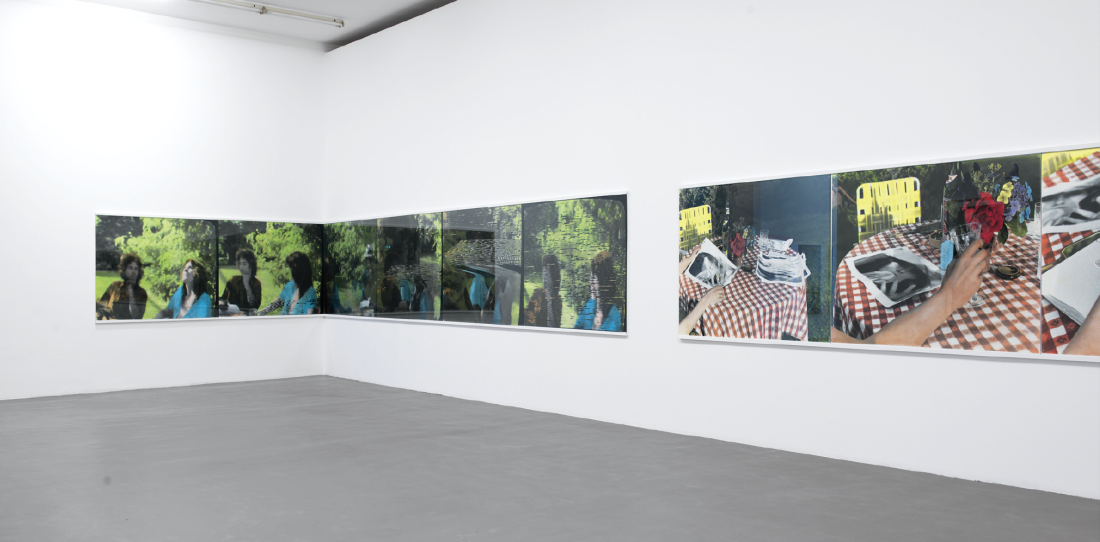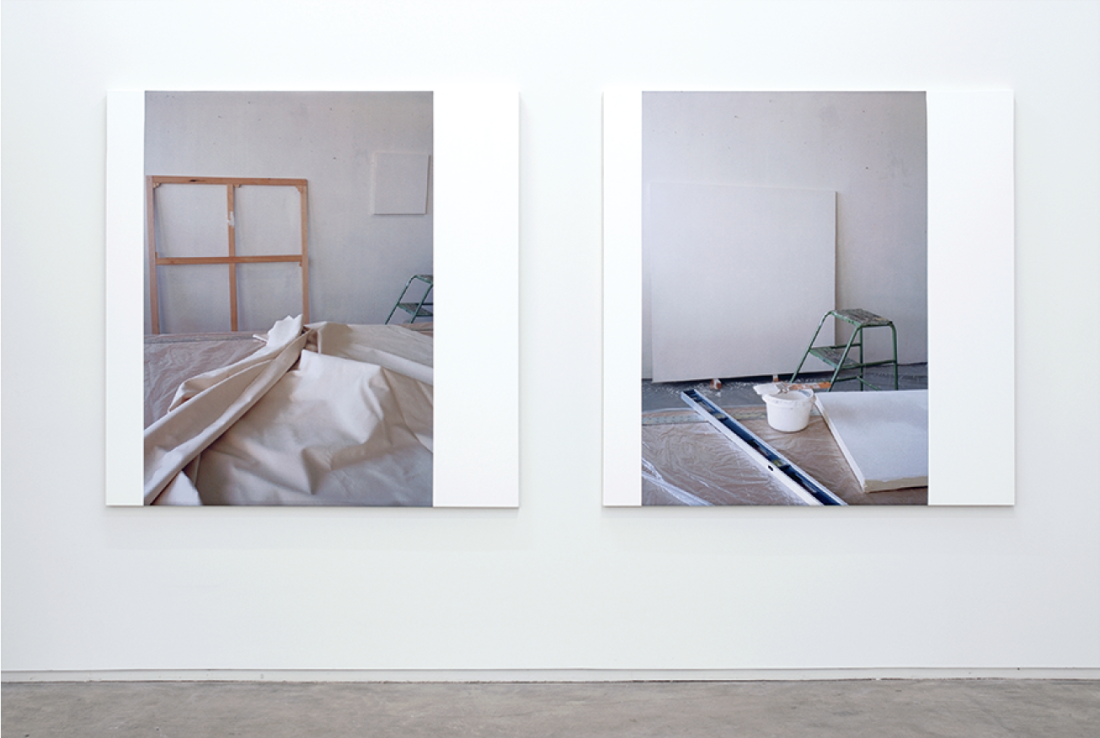Ian Wallace
Mondrian banned “the natural” from his painting, but there are rural views from Dutch trains that always remind me of the “abstract reality” of his later works. Looking out at the primary colours of tulips, for example, one sees picture-plane flat fields divided into squares and rectangles by the dark lines of drainage ditches. These fields are Mondrian-like geometries of compositional variation where no one area dominates and which, in winter, display a simple, architectural absence of colour.
When Ian Wallace argued that Mondrian remained “a 19th century, high romantic” landscape painter, his critique was existential and melancholic. This critique, which concluded his 1969 masters thesis in art history, continues to inform his practice. Whereas critics such as Meyer Schapiro and Clement Greenberg have commented on the presence of the three-dimensional in Mondrian’s abstract work, Wallace uses the flat, high-Modernist monochrome panel as a figurative element in his painting, or has overlaid it with photos that make reference to fin-de-siècle romanticism.
This approach, as self-consciously aware of its own history as it is of the history of art, was one of the pleasures of the Rotterdam exhibition in the major three-venue survey, “Ian Wallace: A Literature of Images.” An initiative of the Witte de With’s director, Nicolaus Schafhausen, in partnership with Kunsthalle Zürich and Düsseldorf’s Kunstverein für die Reinlande und Westfalen, each venue staged its own concurrently running look at Wallace’s production. In Rotterdam, curator Renske Janssen brilliantly assembled over 80 major and minor works, studies and documentation.

“Ian Wallace: A Literature of Images,” installation view at Witte de With, 2008. The Summer Script I & II, 1974, hand-coloured photos, Silver print, 119.6 x 175.3 cm to 120.1 x 176 cm. Courtesy the Winnipeg Art Gallery, Winnipeg and Witte de With, Center for Contemporary Art. Photo: Bob Goedewaagen.
If Mondrian’s theosophist intention overlays his painterly materials like a heavy varnish, in Wallace’s work, material is what it seems to be. Paint is paint, canvas is canvas, and photos are iconically photos. In the case of_ Support/Surface I & II_, 2007, photos of canvas and stretchers being worked on in the artist’s studio are applied with laminate paint to the very same canvas and stretchers depicted in the photos. In Wallace, idea and material often have their own distinct geographies. The two are kept separate the way a hard-edge painter keeps one colour from the next.
This aspect of Wallace’s production was most apparent in the long, thin, starkly coloured acrylic canvases such as Untitled (Grey Monochrome with Yellow), 1967/2008. Wallace has been remaking these early works in dimensions slightly different from the originals, of which only one or two survive. They depict the idea of the monochrome, to borrow the title under which they were first exhibited, and they are what Mel Bochner noted a Malevich wasn’t: “a reproduction of an idea about itself.” Paradoxically, this leaves them with a blank materiality, a quality exaggerated by their installation in the doorways between galleries of the old industrial building or in overlooked, liminal places such as an alcove with a door leading to the stairwell.
Like another early interventionist work, Untitled (White Line), 1969/2007—a long wooden panel lying on the floor of the galley space that encourages the viewer to walk along it—the monochromes directly influence the viewers’ physical relationship to the exhibition space. Untitled (White Line) has a parallel at Utrecht inside Gerrit Rietveld’s 1924 Schroder House, where another large, white floor stripe directs the visitor’s movement and breaks up architectural space. In their intellectual craftsmanship, Wallace’s monochromes are as much Rietveld, the Dutch furniture maker who became the purest of De Stijl architects, as they are Donald Judd, Daniel Buren or Michael Fried, whose 1966 essay, “Shape as Form: Frank Stella’s Irregular Polygons,” influenced Wallace in this period.

Ian Wallace, Support/Surface I & II, 2007, photo laminate with acrylic on canvas, 152 x 152 cm, Nuyten and Dime Collection, Toronto. Photo courtesy the artist and Witte de With, Center for Contemporary Art.
Among the many significant examples of Wallace’s photographic work was the rarely exhibited, twenty-one metre long The Summer Script I & II, 1974. A montage of hand-coloured stills lifted from a film about a failed marriage that Wallace, Jeff Wall and Rodney Graham worked on together and never completed, these works prefigure Wall’s early large-scale photographic work. They are deeply influenced by Roland Barthes’s illustrated essay, “The Third Meaning,” about the semiotic relationship between Eisenstein’s The Battleship Potemkin and the still photos that represent this film in magazines and theatre lobbies. A film should be “scrutinized and listened to attentively,” Barthes paraphrases Eisenstein. But this is impossible given the time-based nature of the medium. In the context of the gallery space, still photos on this grand scale can be read as a turning back of classical, narrative film towards the contemplative, fixed nature of painting.
The hand colouring lends an existential frailness one associates with the instability of perception and emotions. Colour as a form of thought, but with a material verisimilitude, for example, in the image of the red-and-white checkered tablecloth in The Summer Script II, as if its fabric were hand dyed. Black and white photos of the couple featured in The Summer Script I sit scattered on this tablecloth. They come optically forward—“figure” against hand-coloured “ground”—with the formal seriousness of the police record or news photo: a mechanical archive, not tinted by memory.
At Work 2008 includes a video remake of the Super 8mm film component of At Work 1983. In the earliest At Work, Wallace reads Kierkegaard’s On Irony alone at night at a table in an empty storefront gallery. In the most recent version he seems to nonchalantly labour in his studio, but is, in fact, in another gallery space, acting set pieces based on his series of photographs, At Work 1984. This invented studio space is populated by the old copy of On Irony and objects referencing Mondrian and Mallarmé, Wallace’s touchstones. The media used in these works adhere precisely to the actions portrayed—the static, grainy film images belong to the interior, temporal world of a still photo, and the brightly coloured digital work unfolds in the banal real time of video. Both studios are idealized spaces situated somewhere between life and art, public display and private reading. This is precisely the territory inhabited by Gerard Dou, Rembrandt and other 17th-century Dutch painters when they recorded themselves “at work.” ❚
“Ian Wallace: A Literature of Images” was exhibited at Kunstverein für die Rheinlande und Westfalen, Düsseldorf, from October 19, 2008, to January 11, 2009, Witte de With Center for Contemporary Art in Rotterdam from November 8, 2008, to February 8, 2009, and Kunsthalle Zürich from November 15, 2008, to January 11, 2009.
EC Woodley is a composer, artist and critic based in Toronto and Amsterdam.

